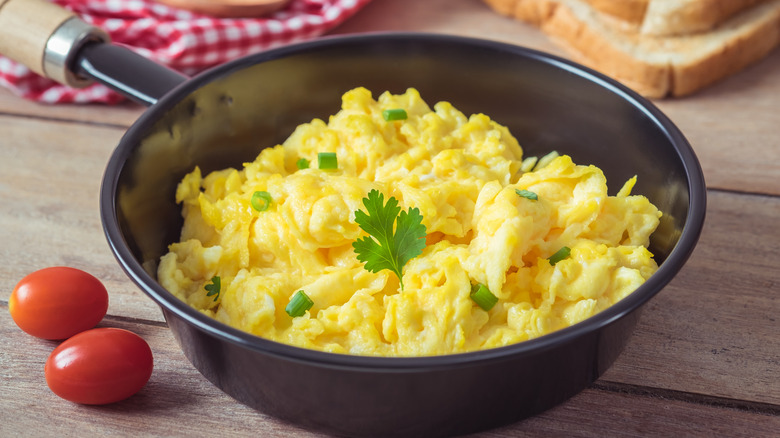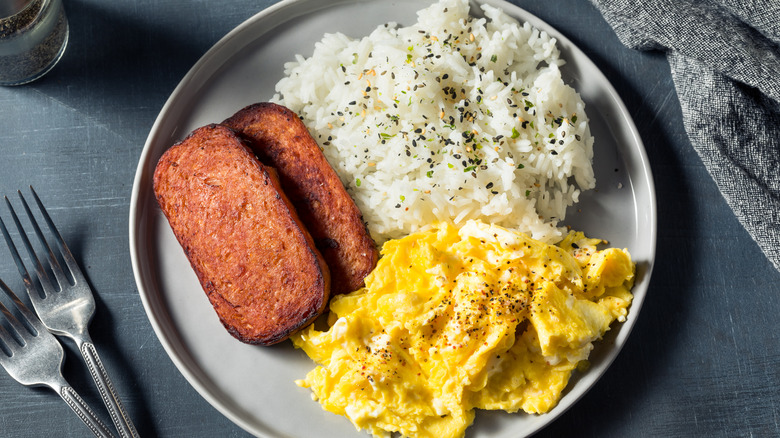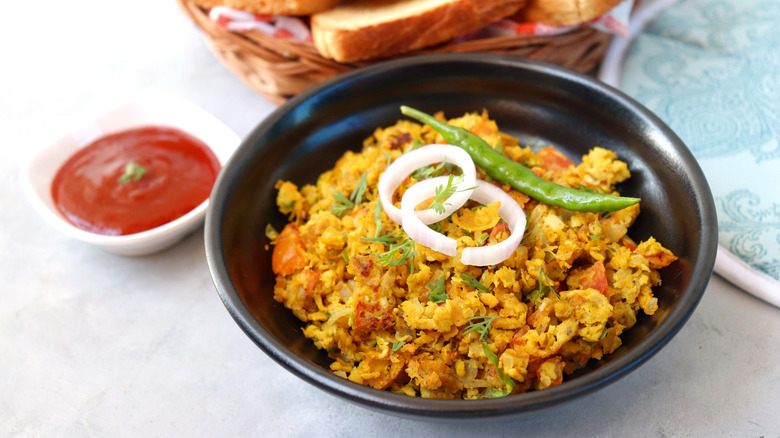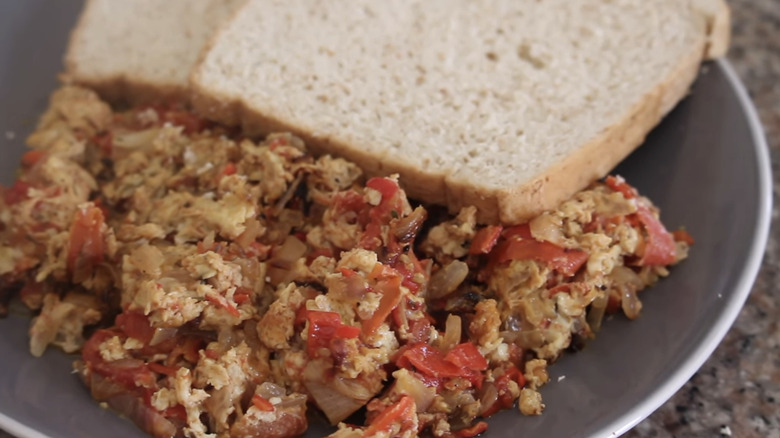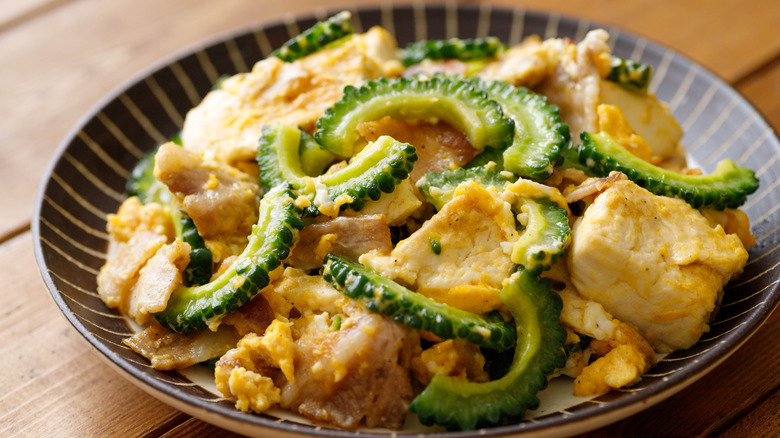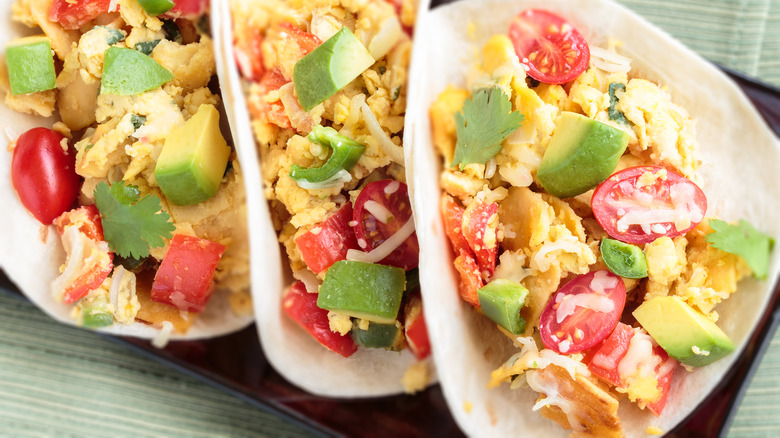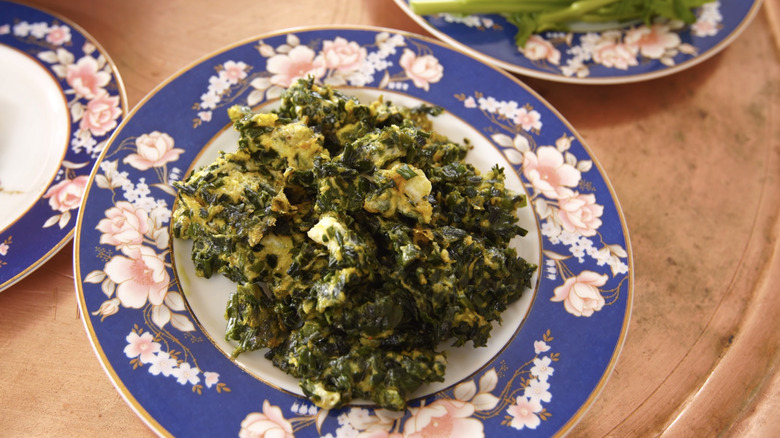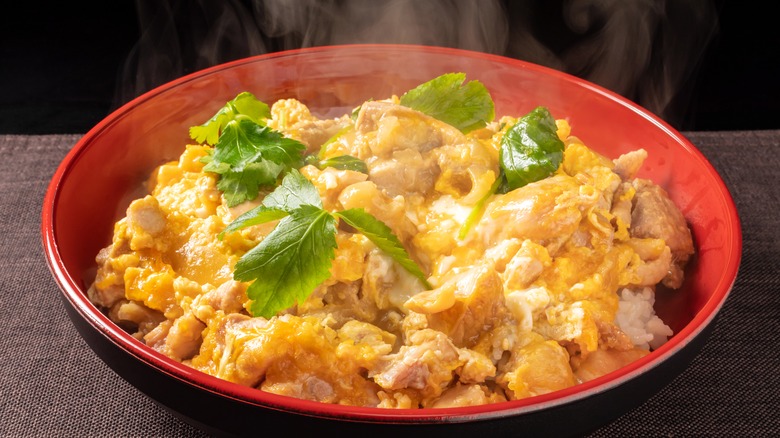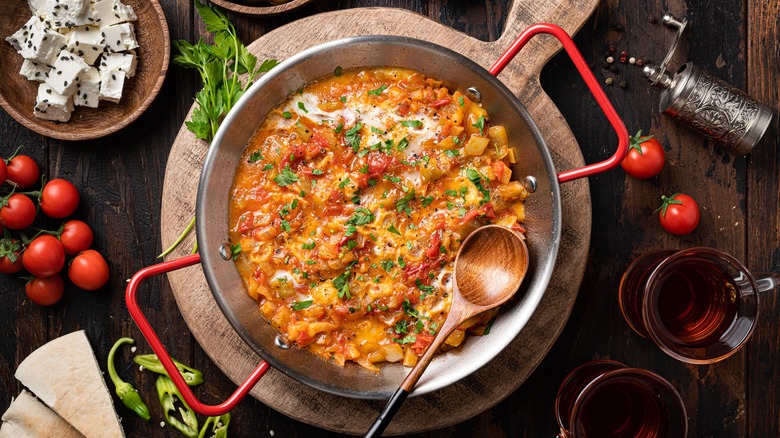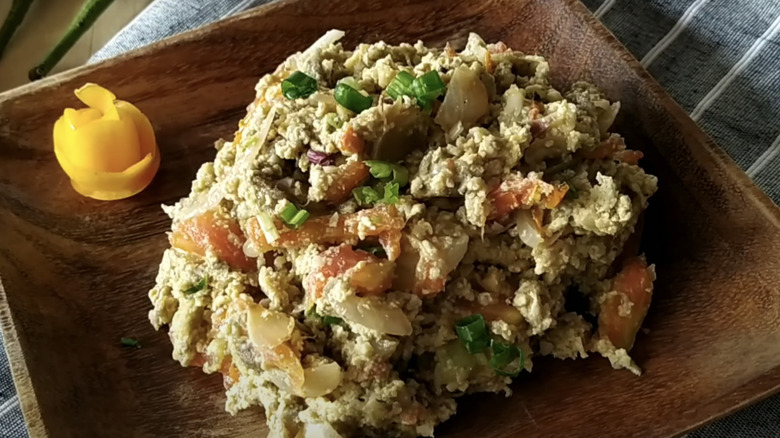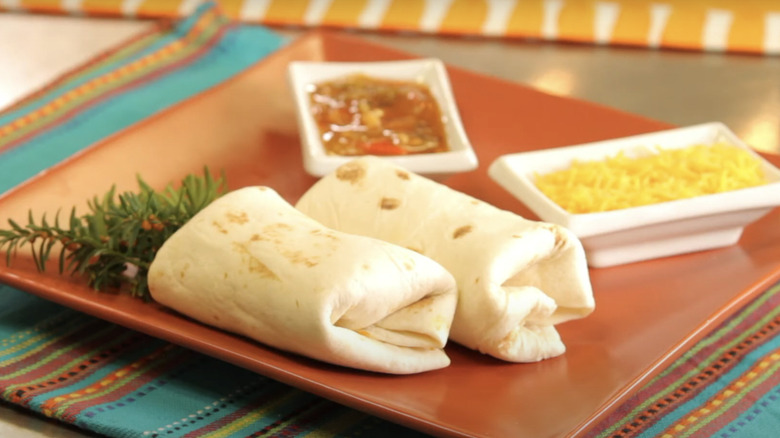11 Ways Scrambled Eggs Are Enjoyed Around The World
Scrambled eggs are one of the easiest meals in the world to make. Packed with nutrition, it's no wonder they're such a popular breakfast! Most people have their preferred way of cooking scrambled eggs, based on the taste and texture they desire. In Western cuisine, there are three main styles that people typically order or make at home.
English-style scrambled eggs are pan-fried over moderate heat: They must be stirred regularly to ensure they don't burn. Firm but still slightly moist, they're usually served on toast. On the other hand, French-style eggs have a much smoother, creamier mouthfeel. They're cooked more slowly, ideally over a bain-marie, for around six minutes. The finished French scrambled eggs have a more custardy consistency, served with a bit of seasoning and butter — a French cuisine essential. These recipes are slightly different from the American style of scrambled eggs, which involves folding the eggs with a spatula while they're in the pan. The American method creates the kind of eggs perfect for a filling diner-style breakfast with all the trimmings!
The beauty of scrambled eggs lies in their versatility. Whether you're serving scrambled eggs at breakfast or as part of an evening meal, there are endless possibilities. From old family recipes to national dishes, there are all kinds of variations of this dish globally. For such a humble food, scrambled eggs are a lot more diverse than you might initially think.
Spam, eggs, and rice – Hawaii
During the 20th century, the American military took spam all over the Pacific. Now, it's a staple food on several islands and Hawaii is no exception. A wholesome way to start a day in Hawaii, the trick to cooking a proper dish of spam, eggs, and rice is to prepare each ingredient correctly. First, the rice should be steamed — this is usually the easy part, as most homes in Hawaii have a rice cooker. A sprinkle of Japanese furikake seasoning adds a finishing touch to the rice, giving both color and flavor.
The spam should be pan-fried and served hot. One can of spam gives about 8 slices, which should be fried until they take on a rosy-brown color. They're then seasoned with a little sugar and Japanese shoyu soy sauce before serving: For this reason, it may be wise to use reduced salt spam to avoid having too much sodium in one sitting. The eggs can be served fried, but scrambled is the preferred way. Lightly beaten and scrambled, they're best seasoned with a little black pepper and a dash of shoyu — gifting you a little slice of island life right in your kitchen!
Akuri – India
South Asian cuisine is known for its complex flavors and fiery spices and even scrambled eggs follow this trend. Akuri is a scrambled egg dish enjoyed by the Parsi people of India, who include eggs in all of their most beloved recipes. Akuri is packed with flavor, filled with chopped onions, tomatoes, fresh green chillis for a spicy kick, and a generous amount of garlic. Ideally, the eggs should be lightly whisked with some fresh cream to give the finished dish a soft and smooth texture.
The trick to cooking akuri is to sauté the vegetables first until the onions are soft and glassy. Only then should you add the eggs, but be careful not to overcook them, which can make them too rubbery. For a good akuri, the eggs should always stay soft and slightly runny. It's best enjoyed with bread and a little salad. Alternatively, you could try serving this dish with some flatbread like chapati or pita. Whatever the accompaniment, this is a warm and spicy breakfast that is filling but not heavy.
Egg Sauce – Nigeria
Known as egg sauce or egg stew, this Sunday breakfast dish comes with plantains, yams, or bread. Traditionally, Nigerians use dense Agege bread, which soaks up the flavorsome moisture from the finished eggs. Diced onion, garlic, tomatoes, and red bell peppers give these scrambled eggs a distinctive red and yellow color — although you can also add green spring onions, too. Similar to a tomato omelet, this egg sauce contains more tomato, giving it a softer and juicy texture. Most importantly, this dish includes scotch bonnet pepper, filling it with a spicy kick and the unmistakable hot pepper fragrance. Famous as one of the world's fiery peppers, those with lower spice tolerance may want to use half a scotch bonnet.
Nigerian egg sauce is a delicious breakfast, but you can add something protein-rich — like fish or corned beef — to make a more substantial meal. While some prefer to enjoy the eggs solo, something more filling can be helpful if you have a long day ahead.
Goya chanpurū – Okinawa
Ask anyone in Japan to name a typical dish from Okinawa, and there's a good chance they'll say goya chanpurū. Okinawan cuisine is distinct from Japanese, with uniquely favored ingredients and styles. After all, Okinawa was an independent country until Japan annexed its hundreds of islands in 1879. Chanpurū is a type of Okinawan stir fry. While several chanpurū recipes exist, goya chanpurū is the most famous. The goya – bitter melon or bitter gourd in English — is an intensely stringent vegetable that mellows when properly cooked. One trick is to use salt to draw out its excess moisture. But it will lose some bitterness during frying, too.
Goya chanpurū usually includes firm tofu and spam – the latter is thanks to America's cultural influence. However, spam is optional. Sliced pork, lardons, or chopped bacon can be used in its place — or no meat for a vegetarian spin. Of course, it includes beaten eggs that scramble while stir-frying the dish — gently binding ingredients together. Proper seasoning gives this dish its rich umami flavor and inviting fragrance. Sesame oil, soy sauce, and a dash of rice wine improve the dish's flavor. A handful of dried bonito fish flakes can be sprinkled atop as a finishing touch.
Migas – Mexico
Migas is a classic Mexican breakfast and an excellent way to use yesterday's leftover tortillas! The word "migas" is Spanish for crumbs, and the original dish from Spain arrived as a way to use leftover bread. Using tortillas in the Mexican version seems an obvious choice! Rather than going to waste, any old tortillas can be chopped into pieces and fried in a pan to make crispy tortilla chips. The eggs are then added to the same pan and scrambled around the chips with vegetables like tomatoes or jalapeños. The result is a dish with a fantastic blend of textures. The crunchiness of the tortilla chips contrasts with the softness of the eggs and vegetables, giving this dish a distinctive mouthfeel that sets it apart from other scrambled egg dishes. It's best to use slightly stale tortillas and serve with a generous helping of frijoles refritos.
Like many Mexican dishes, there's also a Tex-Mex version of migas. In Tex-Mex cuisine, migas tacos are a popular breakfast food. Putting tortilla chips inside more tortillas may feel a bit odd at first, but its popularity is a testament to its excellent combination. These tacos are great to enjoy as an early breakfast or a later brunch and go nicely with a spoonful of red or green salsa.
Sirabij – Iran
A much-loved piece of old Persian cuisine, sirabij is enjoyed in the Northern provinces of Iran on the shores of the Caspian sea. It's a popular dish, made with fresh garlic greens, which gives it a fresh garlic aroma. Sirabij is most commonly cooked in autumn when garlic greens are in season and readily available in Iranian marketplaces. The egg dish also contains salt, pepper, and turmeric. An easy dish to prepare, it's usually served with bread, rice, or alongside fish or chicken dishes.
Since sirabij needs garlic greens, it may not be easy to cook in parts of the world where they aren't available in grocery stores or markets. Though it may take a fair time commitment, one potential workaround is to grow some greens at home. Garlic often has a habit of sprouting on kitchen counters before it can be cooked. While sprouted garlic is still fine to cook with, it can also be planted in a flowerpot to keep growing. After a few weeks on a sunny windowsill, you'll have some home-grown garlic greens to use in this and other recipes!
Huevos pericos – Colombia
The name huevos pericos translates to "parrot eggs," but there's no need to worry. You won't need any tropical bird eggs to make this delicious dish! The name most likely comes from the bright red and green colors of this Latin American scrambled egg dish — resembling the colors often found on parrots' feathers. This recipe originally comes from Colombia, where it's a popular breakfast meal — though it's also a popular breakfast dish to make or order in Venezuela. If ever there's a good time to use organic, free-range eggs, it's in huevos pericos where the bright sunny yellow of the yolks adds even more color.
Hearty and full of bright flavors as well as colors, huevos pericos are traditionally served with arepas and cheese (ideally Colombian queso blanco). It's also usually accompanied by a steaming mug of hot chocolate — although it goes just as nicely with a cup of hot coffee.
Oyakodon – Japan
In Japanese cuisine, donburi is a category of rice bowl dishes. Names of dishes ending with the suffix –don mean "bowl." Hearty and filling, these are particularly satisfying during cold winter months. Donburi consists of a bed of freshly steamed rice with various toppings. Among visitors to Japan, oyakodon is one of the most popular types of donburi. Simple to prepare, this dish uses chicken and eggs, but its seasoning is what makes the dish shine. The wholesome umami flavors of dashi (fish stock), tsuyu soy sauce, and mirin elevate this dish into pure comfort food.
Oyakodon usually uses chicken thighs, preferred in Japan for their juicier texture and flavor. After being diced, the chicken cooks in hot broth and then is poured over steaming hot rice. Cook the beaten eggs for a few minutes before pouring them atop the chicken. It's important not to overcook the eggs when making oyakodon. They should be slightly runny, so they'll cover the chicken and rice. (The heat from the rice will cook them more anyway.) Like many Japanese dishes, oyakodon has a finishing sprinkling of freshly chopped spring onion and some nori seaweed flakes. It's similar to another famous donburi dish, katsudon, which includes a sliced breaded cutlet instead of chicken pieces with beaten eggs poured over it.
Menemen – Turkey
Menemen makes a filling meal at any time of day. A one-pot meal, it's quick and easy to prepare. Named for the market town of Menemen in Western Turkey, this is essentially a mixture of scrambled eggs, tomatoes, peppers, and (sometimes) onions. Although menemen uses Mediterranean herbs like oregano, those who like their food spicier can add some red chili flakes while it's cooking. We advise cooking this dish until the eggs are only just set, which creates a softer consistency. A trick to getting the texture right is to cook on a gentle heat setting, taking it off the cooker when it's almost finished: This will allow the eggs to finish cooking with residual heat. With its soft and moist texture, it's perfect to enjoy with some fresh and crusty bread.
Menemen is similar to a Maghrebi dish called shakshuka, which uses essentially the same ingredients. Also known as jazmaz in Syria, this dish doesn't scramble its eggs. Instead, it gently poaches them in a spicy tomato sauce — sometimes with chopped black olives. While Turkish menemen is typically a main course, Syrian jazmaz is (usually) a starter dish.
Poqui-poqui – Philippines
Hailing from the Philippines, this dish makes an excellent vegetarian breakfast or lunch. Consisting of fresh tomatoes, roasted eggplants, and scrambled eggs, it's simple to make. First, prepare the eggplant by roasting or grilling it to bring out a nice rich flavor. Then sauté the eggplant with tomatoes, onions, and garlic. Thoroughly whisk the eggs to aerate them, making the finished dish lighter and fluffier. As with many scrambled egg dishes, it's best to take the pan off the heat when the eggs are almost fully cooked, allowing them to finish on residual heat. Like other dishes on this list, poqui-poqui tastes best if the eggs aren't overdone!
For seasoning, all poqui-poqui needs is a pinch of salt — though some people like to use a little fish sauce for extra flavor. This dish can make a wholesome breakfast with some freshly steamed rice, or it can be served as a side dish for a more substantial meal, pairing nicely with fish or meat dishes.
Breakfast burritos – New Mexico
Breakfast burritos are popular in the United States' southern region. Sometimes it's a whatever-food-is-in-the-fridge kind of meal. However, breakfast burritos from New Mexico are a matter of state pride, occupying a similar cultural niche to New York's bagels. It's a flexible dish with plenty of room for variations. Still, a few specific ingredients are essential. A New Mexico breakfast burrito should be wrapped in a soft flour tortilla, containing green chile and scrambled eggs. Reportedly, this dish was invented in Albuquerque in the 1970s and it's remained popular ever since. All kinds of other ingredients can be added to the mixture, depending on personal tastes. Popular additions to this dish include bacon, sausage, diced potato, and red salsa.
To make authentic New Mexico burritos, the green chile peppers should be roasted — adding a characteristic flavor to the dish. Roasted chile is the beating heart of New Mexican cuisine. People in Albuquerque periodically roast batches of green chiles so they can add spoonfuls to dishes whenever needed. For anyone who can't roast their own, tubs of pre-made roasted green chile are readily available in grocery stores. As a testament to how important this ingredient is, roasted chile peppers have even been proposed as the official state fragrance of New Mexico!
